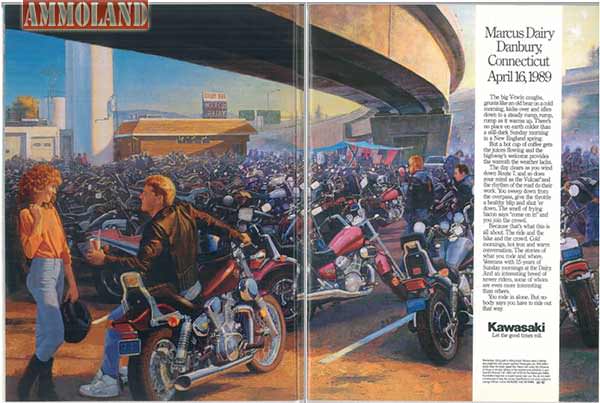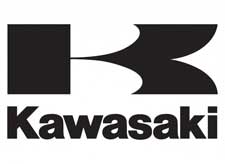

FOOTHILL RANCH, Calif. –-(Ammoland.com)- The same passion for innovation that drives Kawasaki engineering has also propelled its marketing and advertising over the years. Sometimes, the best result comes from far out, innovative thinking, just like with groundbreaking products like the 500 Mach III H1 triple and supercharged Ninja H2 R motorcycles.
R motorcycles.
This was exactly the scenario in 1989 when Kawasaki Motors Corp., U.S.A. (KMC) launched an inventive print advertising campaign informally known as “Hangouts.” Over two years, a dozen well-known bike hangouts were identified – from Marcus Dairy in Danbury, Connecticut to The Rock Store in Malibu, California – with two-page ads created around riders congregating there. In what must stand as one of the earliest forms of social media, the ads were run months ahead of time, announcing the exact location and date and enticing riders to come.
The campaign was conceived by Scott Young, the Executive Creative Director at Bozell, Jacobs, Kenyon & Eckhardt. “Motorcycling is only partly about bikes and how you feel on them; it’s also about sharing with other people,” he explains. “The idea was to find a series of places where motorcyclists hang out, and then write about what it would be like to be there. Since the ads were set in the future, no photos were available, so we hired illustrator Bruce Wolfe to portray them.”

The first Hangout event took place at Marcus Dairy on April 16, 1989. No one at KMC or the agency knew how it would turn out, but what happened exceeded expectations as over 7,500 riders arrived, attracting coverage by the New York Times. Other locations would include Alice’s Restaurant near San Francisco, California; the Old Spanish Trail Restaurant in Bandera, Texas; the Logan Inn in New Hope, Pennsylvania; and the Lookout Roadhouse near Lake Elsinore, California.
About six events were held per year during riding season, with a unique Wolfe painting and Young’s experiential copy anchoring each ad. The paintings were also reprinted as posters, available for purchase at Kawasaki dealerships. Young was surprised to see one picturing the Steamboat Springs, Colorado vintage road races in an Isle of Man pub during TT week in 1992.
Although the first Kawasaki “hangouts” were truly free-flow affairs, later in the campaign, KMC added hospitality and test rides to directly connect attendees with Kawasaki products. But at the end of the day Hangouts was all about, well, motorcycles and hanging out – which meant it was…just perfect.
ABOUT KAWASAKI
Kawasaki Heavy Industries, Ltd. (KHI) started full-scale production of motorcycles over a half century ago. The first Kawasaki motorcycle engine was designed based on technical know-how garnered from the development and production of aircraft engines, and Kawasaki’s entry into the motorcycle industry was driven by the company’s constant effort to develop new technologies. Numerous new Kawasaki models introduced over the years have helped shape the market, and in the process have created enduring legends based on their unique engineering, power, design and riding pleasure. In the future, Kawasaki’s commitment to maintaining and furthering these strengths will surely give birth to new legends.
Kawasaki Motors Corp., U.S.A. (KMC) markets and distributes Kawasaki motorcycles, ATVs, side x sides, and Jet Ski watercraft through a network of approximately 1,100 independent retailers, with close to an additional 7,700 retailers specializing in general purpose engines. KMC and its affiliates employ nearly 3,100 people in the United States, with approximately 260 of them located at KMC’s Foothill Ranch, California headquarters.
Kawasaki’s tagline, “Let the good times roll.”, is recognized worldwide. The Kawasaki brand is synonymous with powerful, stylish and category-leading vehicles. Information about Kawasaki’s complete line of powersports products and Kawasaki affiliates can be found on the Internet at www.kawasaki.com.
